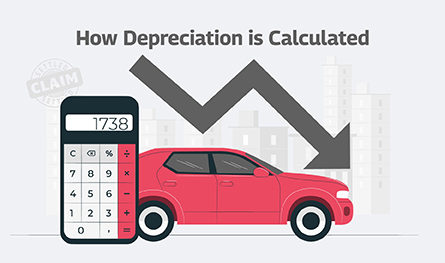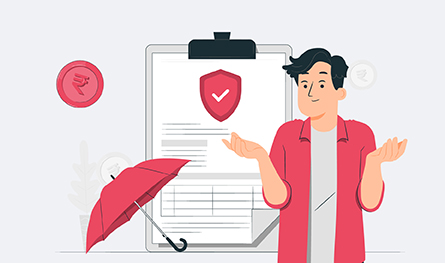How depreciation is calculated for the purpose of claims

Car depreciation implies the difference between the cost of a car at the time of buying the car and when you sell it. A car insurance claim amount is determined by the car depreciation rate. The car depreciation rate is the reduction in the value of your car over its lifespan caused by wear and tear.

What is the Rate of Depreciation on Different Car Parts?
| Depreciation for your car’s plastic and rubber parts | The rate of depreciation is 50% | |
| Depreciation for your car’s fiber glass parts | The rate of depreciation is 30% | |
| Depreciation on metal parts | The rate of depreciation is 0% for the first 6 months. From the 7th month onwards, the metal parts depreciation rate depends on the age of the car. It is 5% in the first year, 10% in the second year, 15% in the third year and so on | |
|
The rate of depreciation is 50% |
How is Car Insurance Depreciation Calculated?
When you make a motor insurance claim, the depreciation is deducted depending on the parts repaired and their respective claim depreciation on car. Let us understand with an example:
Suppose your car suffers damage and is handed for repairs. Here is what the estimated bills look like:
Repairs to broken window – Rs.10, 000
Repairs to plastic parts – Rs.5000
Servicing charges – Rs.10, 000
Total – Rs.25, 000
For this claim, the company would pay the following admissible amount :
Claim payable for repairs to broken window = Rs.10, 000 – 30% depreciation = Rs.10, 000 – Rs.3000 = Rs.7000
Claim payable for repairs to plastic parts = Rs.5000 – 50% depreciation = Rs.5000 – Rs.2500 = Rs.2500
Claim payable for servicing charges – Rs.10, 000
Total claim payable = Rs.7000 + Rs.2500 + Rs.10, 000 = Rs.19, 500
However, if the garage presents a consolidated bill wherein the costs are aggregated and also include painting, 25% of the bill amount would be subject to 50% of depreciation. So, for instance, the above of Rs.25, 000 is presented in one consolidated bill and the car has undergone a fresh layer of paint, 25% of the bill which is Rs.6250 would be subject to a 50% depreciation claim on car. Thus, depreciation of Rs.3125 would be deducted from the total bill and the claim would be settled for Rs.21, 875.
Also Read: BH number plate
Car Depreciation Rate for IDV Calculation
| Age of the car | Rate of depreciation | |
| Up to 6 months |
|
|
| Above 6 months but up to 1 year |
|
|
| Above 1 year but up to 2 years |
|
|
| Above 2 years but up to 3 years |
|
|
| Above 3 years but up to 4 years |
|
|
| Above 4 years but up to 5 years |
|
In case of Constructive Total Loss or theft of your vehicle, the Insured Declared Value (IDV) is paid. The IDV represents the market price of the vehicle less depreciation based on the age of the car. For IDV calculation, the rate of depreciation is as follows:
| Age of the car | Rate of depreciation |
| Up to 6 months | 5% |
| Above 6 months but up to 1 year | 15% |
| Above 1 year but up to 2 years | 20% |
| Above 2 years but up to 3 years | 30% |
| Above 3 years but up to 4 years | 40% |
| Above 4 years but up to 5 years | 50% |
So, if your vehicle was bought for Rs.5 lakhs 2 years before, the applicable IDV would be Rs.5 lakhs – 20% = Rs.4 lakhs. Rs.4 lakhs would be payable if your car gets stolen. In case of a total loss Rs.4 lakhs minus the salvage value, would be payable.
This is how depreciation is calculated for settling claims.
If you are worried of your out-of-pocket expenses due to the effect of depreciation on your car’s parts, you can opt for a zero depreciation add-on cover in your policy. This cover nullifies the effect of depreciation and the insurance company pays the entire claim without deducting depreciation. For reducing IDV, you can choose the add-on cover called Return to Invoice which pays the invoice value of your vehicle in case of a total loss or theft.

Author Bio
Paybima Team
Paybima is an Indian insurance aggregator on a mission to make insurance simple for people. Paybima is the Digital arm of the already established and trusted Mahindra Insurance Brokers Ltd., a reputed name in the insurance broking industry with 21 years of experience. Paybima promises you the easy-to-access online platform to buy insurance policies, and also extend their unrelented assistance with all your policy related queries and services.
Other Motor Insurance Products
Latest Post
.jpg)
Having a bike is not just about convenience, it’s a huge responsibility. Financial protection of your two-wheeler is important and the best way to ensure that is to have a bike insurance policy that will protect you in case of an accident, theft or a natural calamity. There are so many options when it comes to policies, making it difficult to know what’s best. This guide makes it easier to choose the best bike insurance policy that is suitable for you.


Non-linked, non-participating term plans are the ones that do not participate in the business and profit of the insurance company. These are fixed premium plans where the policyholder pays a fixed amount to ascertain a guaranteed sum as a return to be paid to the nominee in case of his/ her demise. Let’s learn more in this post.


Car depreciation implies the difference between the cost of a car at the time of buying the car and when you sell it. A car insurance claim amount is determined by the car depreciation rate. The car depreciation rate is the reduction in the value of your car over its lifespan caused by wear and tear.


Have you ever caught yourself lost in illusions about your daughter's future events, such as her university convocation and first day at work? Her university convocation. When she embarks upon her initial job after graduation will be the day.

.png)
Accidents can happen anywhere, anytime, by your own fault or another person. What’s important is to be prepared for such mishaps. This is where Own Damage Car Insurance comes in handy.






 Car Insurance
Car Insurance
